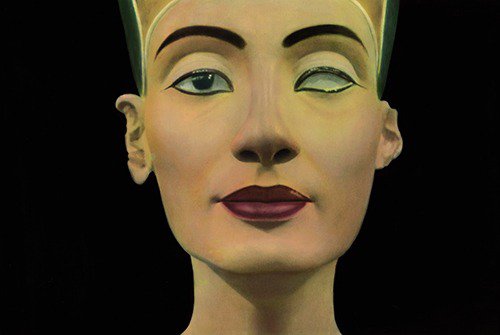Le Theoreme de Nefertiti
dal 21/4/2013 al 7/9/2013
Segnalato da
Ghada Amer
Armand
Armenak Arzrouni
Mohamad
Said Baalbaki
Taha Belal
Adam Broomberg
Oliver Chanarin
Honore Daumier
Thomas Demand
Maurice Denis
Rudolf Ernst
Mamduh Muhamad Fathallah
Francis Frith
Georg Frey
Alberto Giacometti
Gilbert & George
Georges Henein
Candida Hofer
Iman Issa
J & K
Janne Schafer
Kristine Agergaard
Emily Jacir
Ida Kar
William Kentridge
Paul Klee
Susanne Kriemann
Little Warsaw
Balint Havas
Andras Galik
Maha Maamoun
Luigi Mayer
Lee Miller
Amedeo Modigliani
Mahmoud Moukhtar
Vik Muniz
Youssef Nabil
Xenia Nikolskaya
Amy Nimr
Lorraine O'Grady
Grayson Perry
David Roberts
Georges Sabbagh
Nida Sinnokrot
Thomas Struth
David G. Tretiakoff
Kees van Dongen
Van Leo
Alexander Boyadjian
Ai Weiwei
Ramses Younan
Ala Younis
Bassem Yousri
Sam Bardaouil
Till Fellrath
21/4/2013
Le Theoreme de Nefertiti
Institut du Monde Arabe, Paris
The journey of an art work: the making of an icon. The exhibition explores the visual and literary mechanisms by which artworks come to acquire a range of meanings and functions that can embody a number of diverse, and at times conflicting, narratives.

Curated by Sam Bardaouil and Till Fellrath
Le Théorème de Néfertiti (Tea with Nefertiti) explores the visual and literary mechanisms by which artworks come to acquire a range of meanings and functions that can embody a number of diverse, and at times conflicting, narratives. Through employing the Nefertiti bust as a metaphorical thread, and by interrogating the contested history of Egyptian Museum collections from the 19th century onwards, the exhibition is concerned with the critique of museology, the staging of the artwork and the writing of art- historical narrative as a means of forming and informing cultural otherness.
The exhibition is organized along three thematic chapters that reflect on the process of appropriation, de-contextualization and re-semanticisation that an artwork undergoes as it travels through time and place. The "Artist" section highlights the artist's formalistic departures and contributions as evidenced through the artworks on display. The "Museum" section examines the institutionalization of art interrogating how the context in which an artwork is presented bestows on it new meanings and functions. The "Public" section maps out the unpredictable evolution of art as it expands beyond the atelier and the museum and gets coerced into the writing of problematic meta-narratives.
Le Théorème de Néfertiti (Tea with Nefertiti) is constructed around a series of juxtapositions and groupings of historic, modern and contemporary artworks and documents. This is intended as a gesture towards breaking away from more familiar museum classifications that have been conventionally based on geography, periods and style. It proposes alternative paradigms for art-historical construction that transcend the confines of geo-temporal linearity. These constructs are conceived as pointers to an ongoing process of cultural transfer, of appropriation and negotiation that exists beyond the parameters of a much-contested historiography.
The artists featured in the exhibition are Ghada Amer, Armand (b. Armenak Arzrouni), Mohamad-Said Baalbaki, Taha Belal, Adam Broomberg & Oliver Chanarin, Honoré Daumier, Thomas Demand, Maurice Denis, Rudolf Ernst, Mamduh Muhamad Fathallah, Francis Frith, Georg Frey, Alberto Giacometti, Gilbert & George, Georges Henein, Candida Höfer, Iman Issa, J & K (Janne Schäfer & Kristine Agergaard), Emily Jacir, Ida Kar, William Kentridge, Paul Klee, Susanne Kriemann, Little Warsaw (Bálint Havas and András Gálik), Maha Maamoun, Luigi Mayer, Lee Miller, Amedeo Modigliani, Mahmoud Moukhtar, Vik Muniz, Youssef Nabil, Xenia Nikolskaya, Amy Nimr, Lorraine O'Grady, Grayson Perry, David Roberts, Georges Sabbagh, Nida Sinnokrot, Thomas Struth, David G. Tretiakoff, Kees van Dongen, Van Leo (b. Alexander Boyadjian), Ai Weiwei, Ramses Younan, Ala Younis, and Bassem Yousri.
The exhibition also includes a number of artworks that are conventionally labeled as Pharaonic, Coptic and Islamic by artists whose names are now unknown.
The exhibition will be on view at IMA from April 23 till September 8. It was on view at Mathaf: Arab Museum of Modern Art in Doha from November 17, 2012 till March 31, 2013. It will travel to IVAM in Valencia from October 30, 2013 till February 7, 2014 followed by BOZAR, Brussels in the spring/summer of 2014. A bilingual (French/Arabic) catalogue is published by IMA and SKIRA. An English/Arabic version of the catalogue is available through Mathaf: Arab Museum of Modern Art in Doha.
An academic symposium will take place on June 26 and 27 based on the themes of the exhibition at the Institut National d'Histoire de l'Art (INHA), Paris.
Image: Youssef Nabil, Nefertiti, Berlin 2003, 2003
Institut du Monde Arabe
1, rue des Fosse' Saint Bernard, Place Mohammed V, Paris
Opening hours:
From Tuesday to Friday: 10 am–6 pm
Week end and public holiday: 10 am–7pm



